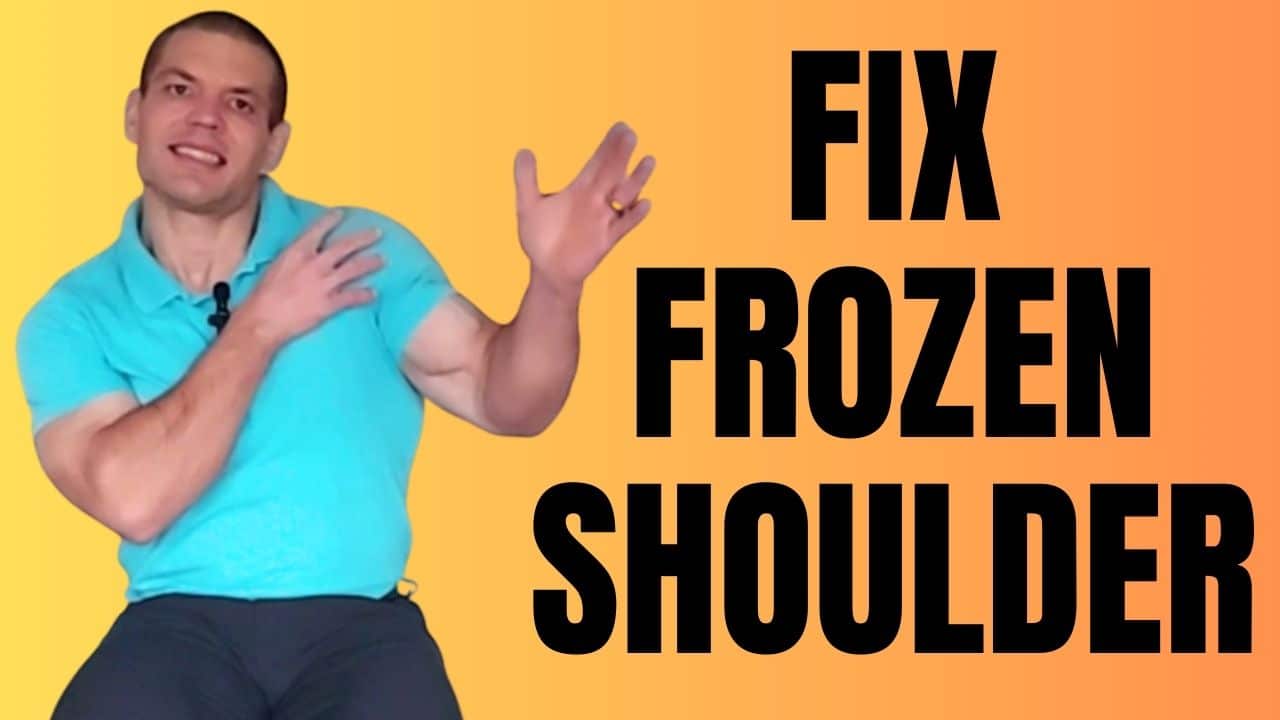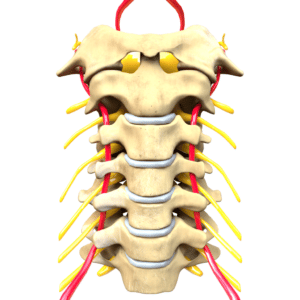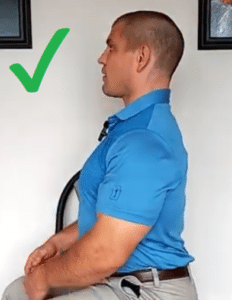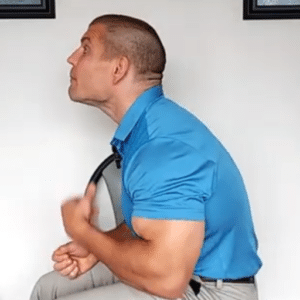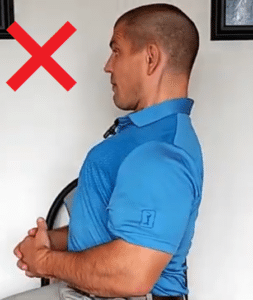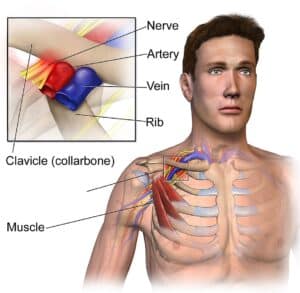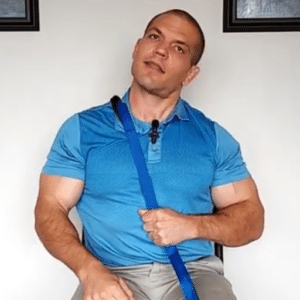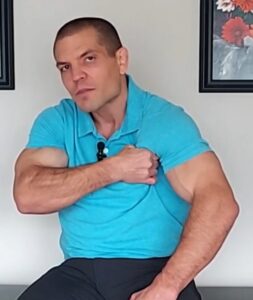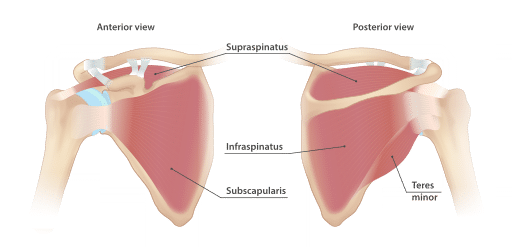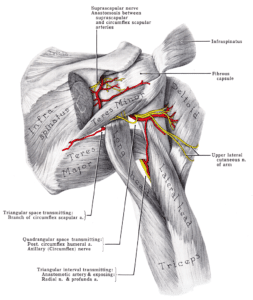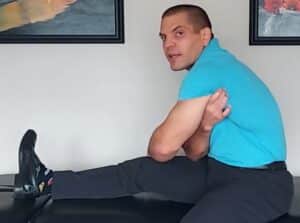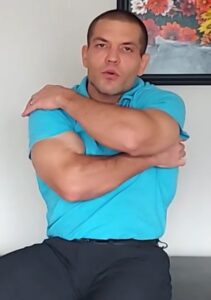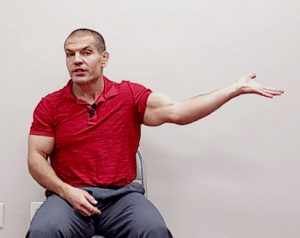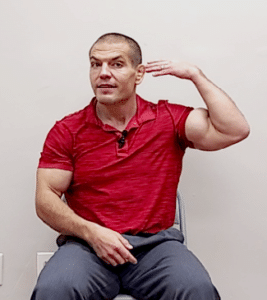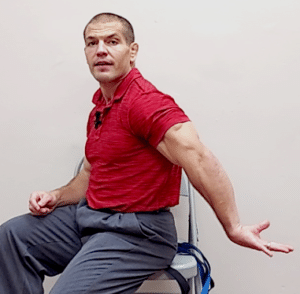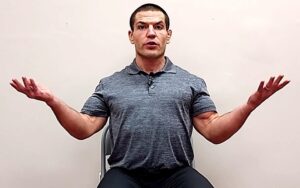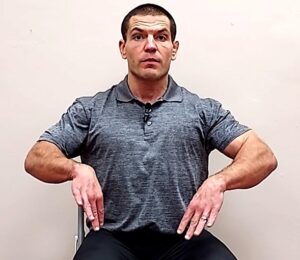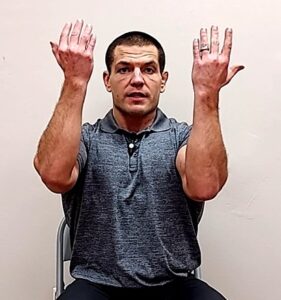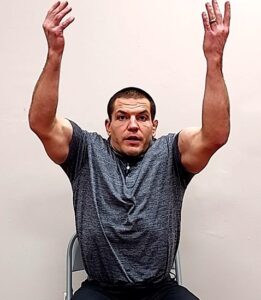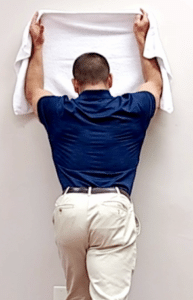What Causes Frozen Shoulder & What Exercises Can Help?
Watch the video below to learn what causes a frozen shoulder (it might NOT be adhesive capsulitis) plus some exercises and other treatments that you may not have thought of
Table of Contents
- What Is Frozen Shoulder?
- Quick Relief From Frozen Shoulder
- What Causes Frozen Shoulder?
- Frozen Shoulder Treatment
- Frozen Shoulder Massage Techniques That You Can Do At Home
- Nerve Glide Exercises For Quick Relief From Frozen Shoulder
- Frozen Shoulder Exercises To Improve Range of Motion
- Other Tips To Relieve Frozen Shoulder
- Need Treatment For Frozen Shoulder?

What Is Frozen Shoulder?
Before we jump into the exercises and massage techniques for frozen shoulder, it helps to understand a little bit about the nature of frozen shoulder.
Frozen Shoulder vs Adhesive Capsulitis
The terms frozen shoulder and adhesive capsulitis tend to be used interchangeably.
However, but frozen shoulder is more of a clinical diagnosis, meaning a stiff, painful shoulder that's limited in all directions of motion. Adhesive capsulitis, on the other hand, is an anatomical finding where the capsule around the shoulder is inflamed and thickened, and that does limit your range of motion.
But not all frozen shoulders have adhesive capsulitis.
It's very possible to have a shoulder that's stiff, painful, and limited in motion without having adhesive capsulitis.
Quick Relief From Frozen Shoulder
So how do you relieve a frozen shoulder fast?
Frozen Shoulder Cures In 1 Minute???
There are claims on the internet about 1 minute cures for frozen shoulder.
Be careful with claims like these!
If it sounds too good to be true, it probably is.
Healing a frozen shoulder does take some time.
However, with the frozen shoulder exercises and massage techniques below, you can likely improve your shoulder range of motion in weeks to months rather than years.
Now these techniques work most quickly for people with a clinical diagnosis who don't have true adhesive capsulitis on an MRI.
However, even if you do have adhesive capsulitis on your MRI, these tips will still probably be helpful. It just might take a little bit longer to fully recover.
What Causes Frozen Shoulder?
The exact cause of frozen shoulder is unknown.
However, it happens nearly four times more in women than in men. It's more common in the 40s to 60s, and it's more common in people with diabetes or thyroid disorders.
Furthermore, I've noticed clinically that almost all cases of frozen shoulder that I see tend to have a high level of nerve irritability.
Irritable Nerves in Frozen Shoulder
The nerves to your shoulder all come out of your neck.
It's very common for people with frozen shoulder to have some underlying nerve pathology in their neck, particularly at the C5 level, which innovates the shoulder.
Frozen Shoulder Treatment
For the treatments for frozen shoulder, we're going to start from the neck and then move progressively down towards the shoulder.
Neck Stretches for Frozen Shoulder
Start out with good posture with your head over your shoulders and chin tucked.
Avoid sitting with a forward head as shown below..
It's not a chicken neck where you're really pulling your neck back either though.
Just do a slight head nod bringing your chin down.
That puts your neck in a neutral position and helps maximize the spaces where the nerves come out of your neck.
Around the 40s to 60s, you also start to lose some space between your vertebrae due to degenerative discs in the neck.
Doing this slight chin nod exercise maximizes the spaces where the nerves to your shoulders come out.
First Rib Mobilization Exercise
For the next treatment, we're going to use a stretching strap like the one below.
RangeMaster Stretch Strap, Multi-loop St...
7% OffIf you don't have one, you can also use a dog leash, bed sheet, or beach towel instead.
Sit on one end of the strap and pull the other end over your shoulder, pretty close to your neck.
Now, this will pull down on your first rib.
This is important because the nerves that come out of your neck move over top of that first rib en route to the shoulder.
So use the strap to hold the first rib down. Then you can stretch the scalene muscles that attach to the first rib by just tipping your neck over to the side.
Hold the stretch for about a second and repeat 10 to 15 times.
You don't want to really push it with this exercise. Just go till you feel a slight pull in the neck and then come back up.
So that's the second exercise. Next, we're going to move down to the chest.
Frozen Shoulder Massage Techniques That You Can Do At Home
The brachial plexus or nerve bundle to your shoulder next runs underneath your chest muscles, and particularly the pectorailis minor.
Pectoralis Minor Trigger Point Release
To release the pec minor, you can put your fingers underneath your chest muscles so that the back of your fingers rub against your ribcage.
Then you're going to squeeze or pinch the chest muscles between your thumb and your fingers.
You may find a spot that feels somewhat tender.
Gently pinch and hold on that area for about a minute. (You don't need to squeeze as hard as you possibly can.)
Next, we'll move to the rotator cuff muscles. These are the small, tiny muscles that stabilize your shoulder joint.
When you have a frozen shoulder, it's very common for the rotator cuff muscles to be in spasm.
Teres Minor and Teres Major Trigger Point Release
The first technique is for the teres minor. It's along the outside of the shoulder.
Your teres major (not technically part of the rotator cuff), also runs right next to the teres minor.
To release the teres minor and teres major, pinch and hold the little muscles between your arm bone (humerus) and your shoulder blade (scapula).
This is important for frozen shoulder relief because, as shown above, your axillary nerve to your shoulder runs between the teres minor and teres major.
The radial nerve that runs down the back of the arm also runs between the teres major and 2 heads of your triceps.
Feel for tender spots in the muscles along the shoulder blade and hold gently for about a minute.
Subscapularis Trigger Point Release
The next muscle is the subscapularis. The subscapular is an internal rotator of your shoulder that lies on the front of the shoulder blade.
This muscle is often very stiff in people with frozen shoulders.
The release technique is similar to the one above.
You'll still put your thumb in the armpit, but instead of pinching the muscles as above, you're going to try to touch the front of your shoulder blade with your thumb.
Reach with your thumb until you feel like you hit a solid wall of bone.
Find an area where it's tender or knotted, and again, hold a gentle pressure there for about a minute.
Infraspinatus Trigger Point Release
The next area is in the back of your shoulder, a muscle called the infraspinatus.
The infraspinatus is an external rotator of your shoulder, but it also limits internal rotation of the shoulder.
These motions are usually both very limited in people with frozen shoulder.
It's hard to reach the infraspinatus on your own, so you can use a tennis ball to help release it.
To do that, take the tennis ball and put it on a firm bed or a floor. Lie down with the tennis ball right underneath your shoulder blade.
Move around until you feel like you've got pressure right on the shoulder blade.
This should be a little bit tender if you get to the right spot. Then lie there for about a minute.
Rhomboid Trigger Point Release
Additionally, the muscles between the shoulder blades, particularly the rhomboids, can get stiff when you have a frozen shoulder.
As you raise your arm, your shoulder blade has to move on your trunk.
And so you can release the rhomboids using a tennis ball just like above.
However, instead of laying directly on the shoulder blade, you're going to put the tennis ball between your shoulder blade and your spine.
Nerve Glide Exercises For Quick Relief From Frozen Shoulder
You'll notice that all of the tips so far haven't really focused on moving the shoulder.
That's because when you have a frozen shoulder, particularly during the early or freezing phases of the frozen shoulder, it's very painful to move the shoulder.
So doing things that reduce the neural irritability as well as help release the tension or stiffness in some of the muscles makes it much easier and less painful to move your shoulder.
But you do eventually need to start moving your frozen shoulder.
One way to start moving your shoulder is to do nerve glides.
This gets the nerves in your arms moving and less sensitive before we actually start moving the shoulder itself.
Median Nerve Glide Exercise
To do a median nerve glide, the nerve that runs down this way, you want to start out with your elbows at your side.
Next, touch your shoulder, and then straighten your arm again.
You want to extend your palm backwards when your arm is fully straight.
Repeat that sequence about 10 to 15 times every few hours throughout the day.
Radial Nerve Glide Exercise
Next, we're going to work on the radial nerve.
The runs through the back of the arm through the triangular interval (the space between your teres major and triceps).
To do the radial nerve glide, first start with your elbow bent and palm in. Then straighten your elbow while turning your palm out.
Repeat these movements about 10 to 15 times.
Frozen Shoulder Exercises To Improve Range of Motion
Next we'll move on to range of motion exercises for frozen shoulder.
In reality, you don't need to do a bunch of different range of motion exercises for your shoulder.
Just doing the two exercises below consistently will help you improve your shoulder range of motion.
Keep in mind that both of these exercises should be done in a relatively pain-free range of motion.
These are NOT "no pain, no gain" exercises.
You should either feel better or at least no worse after doing your exercises.
However, by doing these 2 exercises several times daily, you should start to see improvements in your shoulder range of motion.
Frozen Shoulder Exercise To Improve Internal and External Rotation
The first exercise is to work on internal and external rotation of the shoulders.
To do that, you can start out with your arms out to your sides in external rotation.
Then come bring your arms into internal rotation as if you're trying to touch your hips or go past them.
Then come back out to external rotation and repeat the process about 10 to 15 times.
Again, repeat this often throughout the day, ideally every few hours.
Frozen Shoulder Exercise To Improve Flexion Range of Motion
Next, we're ready to move on to the shoulder flexion exercise.
Flexion is the motion of moving your arm forward as if reaching overhead.
To do this exercise, start out with your forearms parallel and then just raising them up as high as you feel comfortable going.
Then lower your arms and repeat.
It is important to maintain external rotation as you raise your arms.
Just go up as high as you feel comfortable going, and then shrug your shoulders up a little at the top of the movement.
This gets your shoulder blades into the motion.
If that's hard for you to do, there is an alternative variation you can use, sliding your arms up a wall.
That helps offload the weight of your arms and makes the motion a little bit easier.
Using a towel under your forearms can allow your arms to slide a little easier if you aren't wearing long sleeves.
Slide your arms up the wall as much as you feel comfortable going. Then again, shrug your shoulders slightly, and then slide your arms back down the wall.
Other Tips To Relieve Frozen Shoulder
Control Blood Sugar / Diabetes
In addition to doing exercises, keep in mind that diabetes is highly linked to frozen shoulder.
Make sure to eat a healthy diet that's low in processed sugars and grains. When choosing carbohydrates, stick to whole grains, fruits, and vegetables.
Additionally, eating enough protein and healthy fats helps stabilize your blood sugar and prevent peaks and valleys.
Furthermore, it's a good idea to check with your doctor about getting your blood sugar and A1C checked if you haven't already done so.
Check Thyroid
Thyroid disorders are highly related to frozen shoulder. If you haven't had your thyroid checked in awhile, it's probably worthwhile to check with your doctor about getting it tested.
If the test comes back normal but you still suspect that you may have a thyroid problem (fatigue, lack of energy, weight gain), there are some more thorough tests.
A thorough thyroid panel should include TSH, Free T4, Free T3, Thyroglobulin Antibodies (TgAb) and Thyroid Peroxidase Antibodies (TPOAb), and Reverse T3.
If your doctor won’t prescribe the tests (or your insurance won't pay for them) you can also buy the tests online on your own at YourLabWork.com using the links below:
Thyroid Bundle: TSH, Free T4, Free T3, TgAb, and TPOAb
and
Reverse T3 (Specialty Test)
Frozen Shoulder Physical Therapy
Additionally, it is a good idea to seek out help from a physical therapist... particularly one who has experience doing manual physical therapy on patients with frozen shoulders.
There is a prevailing thought process that frozen shoulder physical therapy has to be painful.
That's not the case!
Using a finesse approach works much better than an "no pain, no gain" approach.
Need Treatment For Frozen Shoulder?
If you have a frozen shoulder and you'd like to relieve pain and regain your range of motion more quickly (without increasing your pain in the process), tap the button below to request an appointment with one of our orthopedic manual physical therapy specialists.

